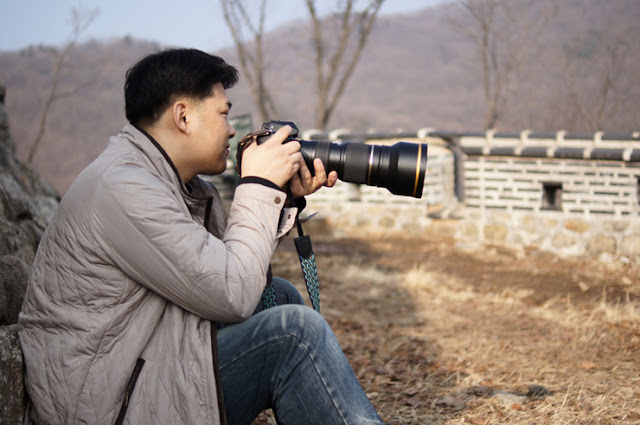Alpha NEX-C3 inherit the advantages of the existing NEX series is a product developed by Sony compact mirrorless camera as 'APS-C' type of image such as the DSLR's heart and became a much more compact body and sensors were mounted intact. Changed NEX-C3 of the main features from now on, let's look at them one.
Biggest advantage of the mirror-less easy to carry, but the image quality is that you can extract. Alpha NEX-C3 was able to confirm that the existing NEX series was 6% lighter than reduced volume over a significant portion. Alpha NEX-C3's weight is 225g or so typical compact cameras, smartphones and similar weight.
NEX-C3 in the existing series and the high-resolution APS-C type (Sony Exmore APS HD CMOS) sensor is mounted. Effective Pixels Approx 1620 proud of the million-pixel high-definition with Sony BIONZ engine to the quality of the photos one step further exalt.
Engine, BIONZ image processor Sony's personally have considerable satisfaction. BIONZ engine of development a200 a300 started touching from the early alpha users as really a surprise until the very funny. Slicing blow past the stigma of noise wise Sony products also have sensors.
One downside to the BIONZ processor is constantly changing and evolving, even seeks red with the same name and the existing says she is. Canon's Digic Digic 4 BIONZ engine, like a change in the performance, depending on the serial number, etc., that should be good.
Terminology associated with the operation screen and menu, there were a lot of changes. Difficult terminology that was used in the conventional DSLR intuitive word has been changed to make it easier to understand. Name of the exposure or aperture, white balance, etc. that can be easily understood by anyone, including the background blur, brightness adjustment, color has been replaced with the word.
What Dodger features deulyira already know the style of the existing mirror-less for the first time, users who encounter problems eopgetjiman very strange expression is. That's good news for beginners.
Would put the existing NEX series with new features added. Expressed that shooting a person's eye and lip detail 'Soft Skin' settings and a variety of photo effects (Picture Effect) equipped. 'Extract color (Partial Colour)', 'Retro Photo (Retro Photo)', 'Pop Color Pop Colour' features.
The features of the existing NEX3 / 5 users may also be available via a firmware update. That's great!
LCD (Xtra fine) Xtra Fine LCD display, the same as the existing use. In addition, the liquid crystal and down tilt functionality. Support to swivel like Sony's DSLT a55 I hope that was a downer.
Than the existing NEX series, the battery efficiency of 20% has been improved. She says it's possible to shoot approximately 400 chapter a buffer state in the Defeated and the same number of shots vary, depending on the situation, the battery has yielded a 20% increase in efficiency that can give you a very high score.
Noticeable peripherals introduced with the NEX-C3. Above all, welcome bounce flash has been released. Is the formal name 'HVL-F20S' as a guide number of up to 20 Supported Flash. Just what I want That's specification.
Why the disposal of the last review through the NEX description I was right that there was a flash of light intensity as high as possible, bounce Boil so Nani being released from passing me empty my wallet open to see 64.9. What can I do for this?
New 30mm f3.5 macro lens have also been released. Yo guy's a coveted thing. 2.4cm seconds from 1:1 Macro and Closeup Macro lens. Projection, Video.'s Quality seems ... Existing light lens (ED lens and 3 aspherical lenses) macro lens ever. Aperture a little dark here, I think. Am yeoksina bundle design.
Scared, I'm not sure that the kit lens and the 30mm macro lens combination. 'NEX-C3 Macro + bundle' Double renjeukit release, please ㅎ ㅎ
 |
| Dinner's main dish 225g of steak, just the NEX-C3's the weight of the day. |
Try to leave a number of events to sketch pictures.
This photo after a long time not to raise commemorative Sanya ㅎ ㅎ
The society of the day, Ahn Youngmee, was the comedian.
How I look like that really cute? 'Gollum' up how true ...
Alpha NEX-C3 expect that reason! (Sony Alpha NEX-C3's main features?)
Guy has created a lighter but lighter. 'Sony' down, perhaps we can attempt This two rounds president of the mirror system in the meantime, Sony's # 1 march change would not have predicted.
June last year Sony's first mirrorless camera NEX-5, NEX-3 has been released since the market landscape dramatically changed. And spits out only one year less than the market share of 41% (GfK survey) Appendicitis was Jackpot was beyond shocking results. Bloggers around me I prepare NEX-5 haeteotgo NEX Single purchase began.
Jean Body and longer usage time, this is much smaller than the existing NEX NEX-C3 raise more than 50% market share goals through a variety of performance improvements.
NEX-C3 news from the Internet would simply fold NEX-C3 ceremony gain experience, I was just thinking, 'NEX series next grade, huh? "Is deemed to have sufficient possibility. Expect more than a nice guy. :)
NEX-C3 Pink Color Fascinating gaenjeok depends on me euron Sony's new Flash HVL-F20S (released ten thousand, come on, hurry up is me!! .... boil body beats ? ?)






















































